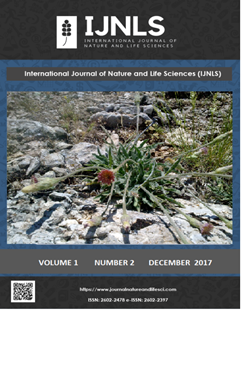Morinda reticulata Gamble Tubers: A Potent Hepatoprotective Agent Against CCl4 and Paracetamol Induced Hepatotoxicity in Wistar Albino Rats
Morinda reticulata Gamble Tubers: A Potent Hepatoprotective Agent Against CCl4 and Paracetamol Induced Hepatotoxicity in Wistar Albino Rats
___
- Akram, E., Pejman, M., Masoud, E. T., Ali, H. R., Shahabaldin, S. (2012). Hepatoprotective effects of pantothenic acid on carbontetrachloride induced toxicity in rats. EXCLI Journal, 11, 748-759.
- Alharbi, N., Imam, F., Nadeem, A., Alharbi, M. M., Iqbal, M., Ahmad, S. F. (2014). Carbon tetrachloride induced hepatotoxicity in rat is reversed by treatment with riboflavin. International Immunopharmacology, 21 (2), 383-388.
- Alhassan, A. J., Sule, M. S., Aliyu, S. A., Aliyu, M. D. (2009). Ideal hepatotoxicity model in rats using carbon tetrachloride (CCl4). Bayero Journal of Pure and Applied Sciences, 2 (2), 185-187.
- Ashoush, I. S., El-Batawy, O. I., Gehan, A. (2013). Antioxidant activity and hepatoprotective effect of pomegranate pell and whey powder in rats. Annals of Agricultural Science, 58 (1), 27-32.
- David, S., Hamilton, J. P. (2010). Drug-induced liver Injury. American Gastroenterology and Hepatology, 6, 73-80.
- Deepak, K. D., Veerendra, C. Y., Siva, S. N., Tirtha, G., Rajalingamd, P. S., Bhim, C. M., Tapan, K. M. (2007). Evaluation of hepatoprotective and antioxidant activity of Lchnocarpus frutescens (Linn.) R.Br. on paracetamol induced hepatotoxicity in rats. Tropical Journal of Pharmaceutical Research, 6 (3), 755-765.
- Garimamishra, R. l., Khosa, P. S., Jha, K. K. (2015). Hepatoprotective potential of ethanolic extract of Pandanus odoratissimus root against paracetamol-induced hepatotoxicity in rats. Journal of Pharmacy and Bioallied Science, 7 (1), 45-48.
- Gini, C. K., Muraleedhara, K. G. (2008). Antioxidant activity of Aulosira fertilisimaon CCl4 induced hepatotoxicity in rats. Indian. Journal of Experimental Biology, 46, 52-59.
- Howida, S., Abou, S. (2016). Physiological changes due to hepatotoxicity and protective role of some medicinal plants. Benisuef University Journal of Basic and Applied Sciences, 5, 134-146.
- Ijinu, T. P, Anish, N., Shyju, H. (2011). Home gardens for nutrition and primary health security of rural poor of south Kerala. Indian Journal of Traditional Knowledge, 10 (3), 413-428.
- Molehin, O. R., Oloyede, O. I., Idowu, K. A., Adeyanju, A. A., Olowoyeye, A. O., Tubi, O. I., Komolafe, O. E., Gold, A. S. (2017). White butterfly (Clerodendrum volubile) leaf extract protects against carbon tetrachloride induced hepatotoxicity in rats. Biomedicine and Pharmacotherapy, 96, 924-929.
- Naik, S. R., Panda, V. S. (2008). Hepatoprotective effect of Ginkgo selectphytosome in Rifampicin induced liver injury in rats: evidence of antioxidant activity. Fitoterapia, 79, 439-45.
- Navarro, V. J., Senior, J. R. (2006). Drug-related hepatotoxicity. New England Journal of Medicine, 354, 731-739.
- Raju A., Joshila, A. (2017). Evaluation of in vitro and in vivo antioxidant potential of Morinda reticulata Gamble tubers in wistar albino rats subjected to ccl4 and paracetamol induced hepatotoxicity. Indonesian Journal of Pharmacy, 28 (3), 147-157.
- Rease, G. E., Evans, W. C. (1989). A Textbook of Pharmacognosy. 13th edn. London; Bailliere Tindall Ltd.
- Rotem, B. S., Yifei, C., Shishi, L., Catherine, H., Michael, R. H., Frederik, N. (2012). The biochemistry of acetaminophen hepatotoxicity and rescue: a mathematical model. Theoretical Biology and Medical Modelling, 9, 55.
- Saumendu D. R., Sumit, D., Dibeyendu, S., Koushik, N. D. (2012). Herbal hepatoprotective agents. A review. World Journal of Pharmaceutical Research, 1 (2), 87-99.
- Thabrew, M., Joice, P. A. (1987). Comparative study of the efficacy of Pavetta indica and Osbeckia octanda in the treatment of liver dysfunction. Planta Medica, 53 (3), 239-241.
- Thangaraj, F. X., Moorthy, K., Leyone, L., Anthonysamy, A., Antony, K. F. R., Subburaman, S. K. (2014). Ethnobotanical study of Kani tribes in Thoduhills of Kerala, South India. Journal of Ethnopharmacology, 152, 78-90.
- Uorakkottil, I., Deepshikha, P., Katare, V. A., Punnooth, P. N. (2016). A review on hepatoprotective and ımmunomodulatory herbal plants. Pharmacognosy Reviews, 10 (19), 66-70.
- Xiaowen, L. I., Rong, Z., Boli., Mei, Z., Qing-Jian, S., Yepeng, Yang., Nan-Yin, H., Zai-Quan, L. I. (2010). Mechanism underlying carbon tetrachloride inhibited protein synthesis in liver. World Journal of Gastroenterology, 16 (31), 3950-3956.
- ISSN: 2602-2478
- Yayın Aralığı: Yılda 2 Sayı
- Başlangıç: 2017
- Yayıncı: Uğur ÇAKILCIOĞLU
Grace M. GOMONET, Ulysses CAGASAN
Raju ASİRVATHAM, Joshila AKHİL
Abolfazl JAFARI-SALES, Behboud JAFARİ, Homeira KHANESHPOUR, Mehrdad PASHAZADEH
Ethnobotanical Features of Ziziphora L. (Lamiaceae) Taxa in Turkey
The Importance of Endangered Anatolian (Oriental) Sweetgum Forests for the Bird Species
